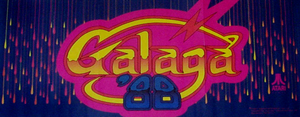Galaga '88 (ギャラガ'88 Gyaraga 'Eiti Eito?) is a fixed shooter arcade game, originally developed and manufactured by Namco in 1987. It is the third sequel for Galaxian (following Galaga, and Gaplus). It features significantly improved graphics over the previous games in the series, including detailed backgrounds, larger enemies and greater ship details. Although it was well received, fewer cabinets of this game were produced than of Galaga and Gaplus. The game runs on Namco System 1 hardware. First ported on the NEC PC Engine, it was later released on the North American TurboGrafx-16 under the name Galaga '90 and the Sega Game Gear in Japan under the name of Galaga'91 (ギャラガ'91 Gyaraga 'Nainti Wan?), and in Europe under the name of Galaga 2.
The gameplay in Galaga '88 is built on the same premise as that of the original Galaga game, but is in many ways more complex and more difficult. The game is divided into a series of 29 Stages distributed through eight Worlds. The starship Galaga accelerates between Stages and Worlds and even to higher dimensions. With the exception of the third and eighth, each World culminates in a Challenging Stage. There are six such stages to engage in, however the design of the enemies and their dancing formations shall vary according to the player's current Dimension. As in Galaga, the objective is to destroy all forty enemies before they fly away off the screen.
Galaga '88 introduces a variety of new enemies and behaviors. Most of these special enemies are worth varying amounts of bonus points when destroyed. Some enemies can combine into larger enemies which take multiple hits to destroy, while others arrive in eggs, explode in a shower of fireworks, grow with multiple hits, or sport armor which makes them invincible while in formation. At the start of the game, the player can select how many Galaga starships to start with (one or two), affecting their number of remaining lives. The game ends after the final boss is defeated, or when the player's last ship is destroyed or captured. The Game Over screen shows the player's hit-miss ratio and a visual representation of their progress.
The backgrounds for Stages 15–17 (the fourth block of stages) consist of the green hexagonal space stations first seen in the 1981 Namco game Bosconian. Additionally, mines similar to those used in Bosconian are used as obliterable "obstacles" in these stages. The game Ridge Racer Revolution features Challenging Stage #2 (Dimension 1) during its loading sequence. Shooting all 40 enemies before they fly away unlocks all of the opponent cars. Ridge Racer 64 also has Challenging Stage #2 (Dimension 1) as a secret bonus but with background music from Ridge Racer 64 itself.
-
Title screen.
-
Atari Games' upright cabinet.
-
The first stage of the game.
Table of Contents
- Galaxian
- Galaga
- Gaplus
- Galaga '88
- Galaxian³
- Attack of the Zolgear
- Galaga Arrangement
- Galaxian Fever
- Galaga: Destination Earth
- Galaga Arrangement (2005)
- Galaga Legions
- Galaga: Special Edition
- Galaga 3D Impact
- Galaga Legions DX
- Space Galaga
- Galaga: Tekken 20th Anniversary Edition
- Galaga Wars
- Galaga Assault
- Galaga Revenge




